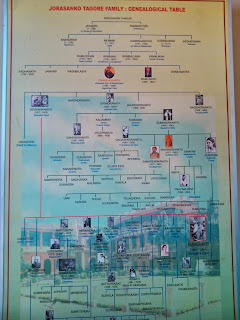Rabindranath Tagore’s Painting Sold Out At Rs. 4.7 Crore
An untitled Tagore painting of a “couple”, from the 1930s, was auctioned by Christie’s on September 22, with a price estimate of between $120,000 and $180,000 (Rs 88 lakh-Rs 1.3 crore). But, the said painting was sold out at the price of Rs. 4.7 Crore ($637,500). The name of the buyer although not disclosed. The painting was acquired directly from Rabindranath Tagore by Edith Andreae, a literary executor and editor of the works of her brother, Walther Rathenau, and her banker husband in Berlin, Friedrich. It was passed on in the Rathenau family as an heirloom. Rathenau was a German industrialist, writer and liberal He considered the painting as “a national treasure”, the painting, mixed media on paper laid on card, measures 56.8cm x 45.7cm, “considerably larger than most of his works”. Christie’s tells prospective buyers that although Tagore “is still best known for his poetry and songs, his importance as an artist was recognised when he became one of nine painters designated Indian National Art Treasures, which means their work is of such cultural value that it cannot be exported”. The painting is therefore rare, says Damian Vesey, specialist in South Asian Modern and Contemporary Art at Christie’s, for one of Tagore’s pictures to come up for The painting “is offered for sale in September’s South Asian Modern+Contemporary Art auction, in a year that marks Tagore’s 160th birth anniversary”. He says that Tagore’s portrayal of the figures in the untitled (couple) is unlike most of his paintings of human subjects. “In the 10 years I’ve been at Christie’s, I’ve never seen a large Tagore watercolour that is so intimate, and there is a softness you don’t see in a lot of his work.” to Vesey, “in the 1920s and early 1930s he was at the peak of his fame, and I think he very much capitalised on that, wanting to spread his ideas and reach to as many people as possible. He felt that his art was able to express something that his writing could not, and having a big exhibition in the thriving art scene of Paris, and then across Germany, would have maximum impact.” He adds: “In Europe, his paintings were seen as the artworks of the guru and mystic, and I think it is very hard to separate the art from the artist at that time.” He thinks it is also hard to say whether the paintings were considered Indian art or modern art. “I think it’s impossible not to see them as modern art, but the pull would have been that they were by Rabindranath from India. There was definitely an element of ‘exotic India’ being an identity marker for these “Tagore’s not really a narrative painter, but there is a specificity to this work and a sensitivity that would make one ask whether it was a portrayal of two actual people or whether it came out of his imagination. And there aren’t many Tagore works you’d ask that question “When he is not painting his fantastical birds, he tends to paint one dominant figure in the centre of the picture, sometimes in profile but more often face-on and with that kind of classically recognisable long nose and mask-like face. So having this intimate image of two figures in profile is very unusual.”
Source: The Telegraph
This is the painting :




Comments